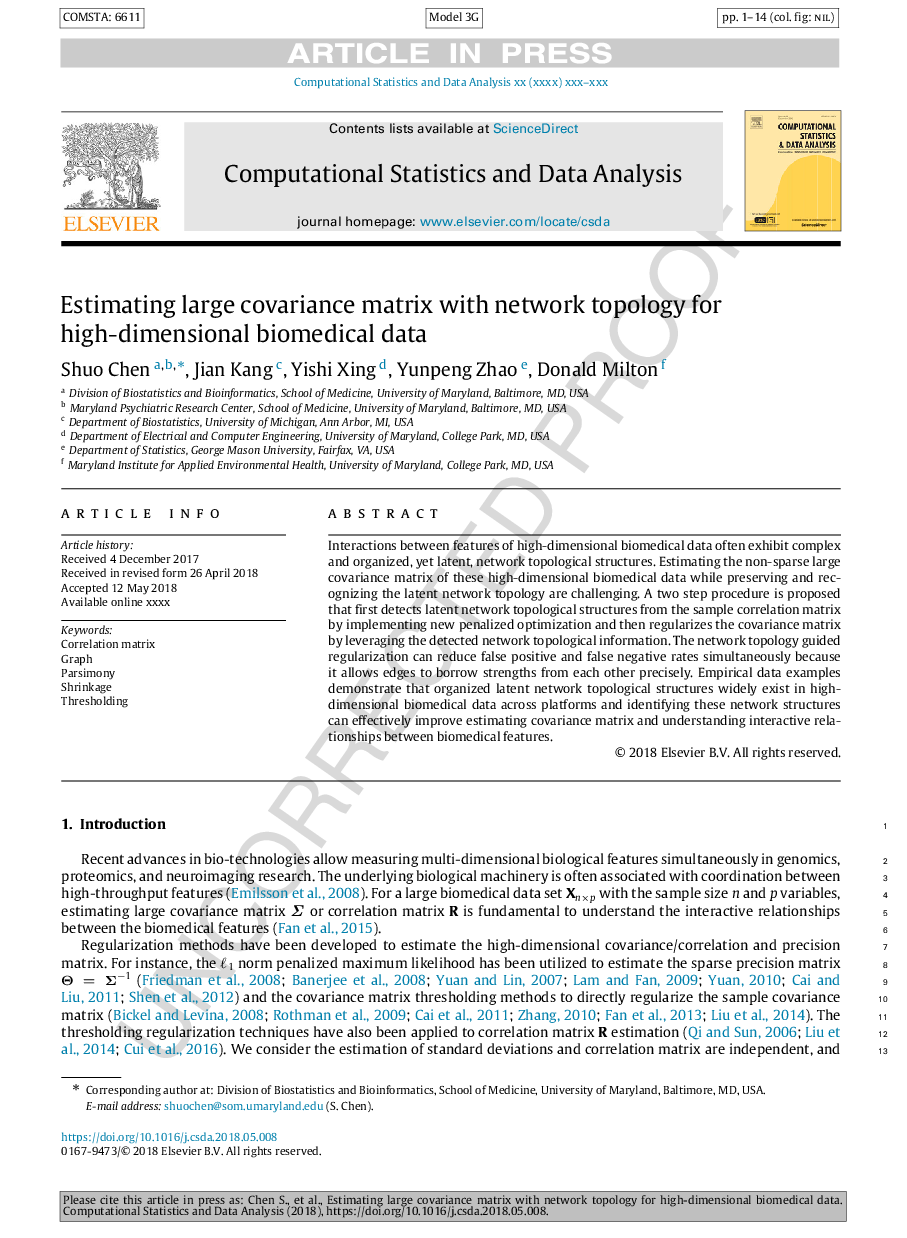| کد مقاله | کد نشریه | سال انتشار | مقاله انگلیسی | نسخه تمام متن |
|---|---|---|---|---|
| 6868603 | 1440029 | 2018 | 14 صفحه PDF | دانلود رایگان |
عنوان انگلیسی مقاله ISI
Estimating large covariance matrix with network topology for high-dimensional biomedical data
ترجمه فارسی عنوان
برآورد ماتریس کوواریانس بزرگ با توپولوژی شبکه برای داده های زیست پزشکی با ابعاد بزرگ
دانلود مقاله + سفارش ترجمه
دانلود مقاله ISI انگلیسی
رایگان برای ایرانیان
کلمات کلیدی
ترجمه چکیده
تعاملات بین ویژگی های داده های زیست پزشکی با ابعاد بزرگ اغلب ساختارهای توپولوژیکی شبکه پیچیده و سازمان یافته، با این حال پنهان هستند. برآورد ماتریس کوواریانس بزرگ ناقص از این داده های زیست پزشکی با ابعاد بزرگ در حالی که حفظ و به رسمیت شناختن توپولوژی شبکه های پنهان شده چالش برانگیز است. یک روش دو مرحلهای پیشنهاد شده است که ابتدا ساختارهای توپولوژیک شبکه های پنهان را از ماتریس همبستگی نمونه با استفاده از بهینه سازی جریمه جدید شناسایی کرده و سپس با استفاده از اطلاعات توپولوژیکی شبکه شناسایی شده، ماتریس کوواریانس را مرتفع می کند. توپولوژی شبکه هدایت تنظیم می تواند به طور همزمان کاهش منفی کاذب مثبت و کاذب منفی را کاهش دهد، زیرا به لبه ها اجازه می دهد دقیقا از قدرت یکدیگر را قرض بگیرند. نمونه های تجربی داده ها نشان می دهد که ساختارهای توپولوژیک شبکه های پنهان سازماندهی شده به طور گسترده در داده های زیست پزشکی گسترده در سراسر سیستم عامل ها وجود دارد و شناسایی این ساختارهای شبکه می تواند به طور موثر بهبود ماتریس تخمین کوواریانس و درک روابط تعاملی بین ویژگی های زیست پزشکی.
موضوعات مرتبط
مهندسی و علوم پایه
مهندسی کامپیوتر
نظریه محاسباتی و ریاضیات
چکیده انگلیسی
Interactions between features of high-dimensional biomedical data often exhibit complex and organized, yet latent, network topological structures. Estimating the non-sparse large covariance matrix of these high-dimensional biomedical data while preserving and recognizing the latent network topology are challenging. A two step procedure is proposed that first detects latent network topological structures from the sample correlation matrix by implementing new penalized optimization and then regularizes the covariance matrix by leveraging the detected network topological information. The network topology guided regularization can reduce false positive and false negative rates simultaneously because it allows edges to borrow strengths from each other precisely. Empirical data examples demonstrate that organized latent network topological structures widely exist in high-dimensional biomedical data across platforms and identifying these network structures can effectively improve estimating covariance matrix and understanding interactive relationships between biomedical features.
ناشر
Database: Elsevier - ScienceDirect (ساینس دایرکت)
Journal: Computational Statistics & Data Analysis - Volume 127, November 2018, Pages 82-95
Journal: Computational Statistics & Data Analysis - Volume 127, November 2018, Pages 82-95
نویسندگان
Shuo Chen, Jian Kang, Yishi Xing, Yunpeng Zhao, Donald K. Milton,
